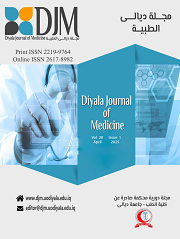Comparison of Muscle to Nodule Strain Ratio Elastography with Parenchyma to Nodule Strain Ratio Elastography in Suspicious Thyroid Nodules
Main Article Content
Abstract
Background: Ultrasound elastography (USE) is a non-invasive technique for distinguishing benign from malignant thyroid nodules. It uses strain ratio to determine thyroid nodular stiffness, however it has limitations when no normal thyroid tissue is present.
Objective: To assess the diagnostic performance of USE in the prediction of malignant thyroid nodules by assessing the strain ratio comparing the normal thyroid tissues as a reference and sternocleidomastoid muscle as a second reference.
Patients and Methods: The study was conducted on 33 patients with single TIRADS III or IV nodules at Al-Imamein Al-Kadhimein Medical City in Baghdad-Iraq for 5 months (August 25th, 2020 to January 15th, 2021), using both gray scale and real-time USE on a Voluson- E6 Ultrasound machine. Final diagnosis has been obtained by cytology and/or histopathology.
Results: The study involved a total of 33 patients, with 78.8% female and 21.2% male. Of these, 72.7% were benign, and 27.3% were malignant. The thyroid nodules were hypoechoic, taller, and micro calcified. The parenchymal-nodular SR of all thyroid nodules ranged from 0.55-6.0, while the muscle-nodular SR ranged from 0.42-5.25. The best (strain ratio) SR cutoff value was (≥3.63) for parenchymal-nodular SR, with sensitivity, specificity, and accuracy rates were 100%, 85%, and 89.2%, respectively.
Conclusion: The study found that sternocleidomastoid muscle has high sensitivity, specificity, and accuracy in predicting thyroid malignancy and differentiating benign from malignant nodules so making it safe for use in certain cases.
Keywords: Elastography, Thyroid nodules, Strain ratio, Muscle.
Downloads
Article Details

This work is licensed under a Creative Commons Attribution 4.0 International License.





